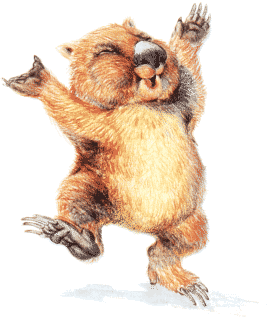|
Okay, so by now you are probably asking your
self, "Self, what is with all of these so-called wombats?" Well,
I would not say that I am obsessed with these creatures from
"down-under", but I do enjoy them. Do not get me wrong, I do
enjoy other animals such as monkeys (always brings a smile to my face),
dolphins, and of course the wolf. The wombat is just an interesting
marsupial not to be mistaken for a rodent.
|

|
|
What is a Wombat according to Wikipedia
Wombats are Australian marsupials in appearance rather like a small, very short-legged
and muscular bear approximately 1 meter in length, and with a mere nubbin of a tail. Wombats feed on grasses, sedges and roots, and dig extensive burrow systems with rodent-like front teeth and powerful claws. Although mainly crepuscular and nocturnal, wombats will also venture out to feed on cool or overcast days. They are not as easily seen as many animals, but leave ample evidence of their passage, treating fences as a minor inconvenience to be gone through or under. Wombats are herbivores, their diet consisting mostly of grass.
Wombats, like all the larger living marsupials, are part of the Diprotodontia, which has two sub-orders: the large and diverse Phalangerida (kangaroos, possums, and relatives), and the Vombatiformes (which is Latin for "wombat-shaped things"). Five of the seven known families are extinct, only the Koala and the three species of wombat survive. The ancestors of modern wombats evolved sometime between 55 and 26 million years ago (no useful fossil record has yet been found for this period) and about 12 species flourished until well into the ice ages. Among the several diprotodon (giant wombat) species was the largest marsupial to ever live. The earliest human inhabitants of Australia arrived while diprotodons were still common, and are believed to have brought about their extinction through hunting or habitat alteration.
Wombats have an extraordinarily slow metabolism, taking around 14 days to complete digestion, and do not move quickly often. When required, however, they can easily out-run a human, and summon immense reserves of strength one
defense of a wombat against a predator underground (such as a Dingo) is to crush it against the roof of the tunnel until it stops breathing. Its primary
defense is its toughened rear hide which, combined with its lack of a meaningful tail, presents a difficult-to-bite-target to any enemy who follows the wombat into its tunnel.
There are three species, all around a meter long and weighing between 20 and 35 kg.
-
The Common Wombat (Vombatus ursinus) is widespread in the cooler and better watered parts of southern and eastern Australia, and in mountain districts as far north as the south of Queensland, but is declining in Western Victoria and South Australia. Common Wombats can breed every two years and produce a single cub, which leaves the pouch after six to nine months but follows the mother about and breast-feeds for another year.
-
The Southern Hairy-nosed Wombat (Lasiorhinus latifrons) is found in scattered areas of semi-arid scrub and mallee from the eastern Nullarbor Plain to the New South Wales border area. It is the smallest wombat at around 775 to 935 mm and 20 to 32 kg, and the young often do not survive dry seasons. It is classified as vulnerable: a healthy population still remains but appears to be ageing: it is feared that the consistently sparse rainfall of recent years has prevented successful breeding. (It takes three consecutive good seasons for a Southern Hairy-nose to reach near-adulthood.) Wombat specialists are concerned that a continuation of the current trend to dryer climate in arid Southern Australia could be a serious threat to the Southern Hairy-nose wombat.
-
The Yaminon or Northern Hairy-nosed Wombat (Lasiorhinus krefftii), was found across New South Wales, Victoria and Queensland as recently as 100 years ago, but is now restricted to a 3 kmē range within the 32 kmē Epping Forest National Park in Queensland. It is probably the rarest large mammal in the world and is critically endangered, with 70 to 100 individuals remaining. It is slightly larger than the Common Wombat and able to breed somewhat faster (two young every three years). However, as mentioned before, it has only approximately 3 kmē of remaining habitat, and that has become infested with African buffel grass, which out-competes the native grasses Yaminon prefers to feed on. A two metre-high predator-proof fence was constructed around 25 kmē of the park in 2000, but captive breeding and translocation programs have been abandoned for the time being because the population in the sole remaining Yaminon colony is considered too small to allow the safe removal of the 15 or 20 individuals needed to start a new wild colony, and because more than a decade of captive breeding research with Common and Southern Hairy-nosed Wombats has produced only a handful of successful births.
|